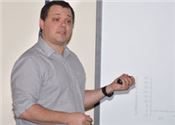|
AgCenter Seminar Focuses On Improving Crop Production

LSU AgCenter plant physiologist Paul South presents findings from his research project RIPE,
Realizing Increased Photosynthetic Efficiency, during a seminar at the LSU AgCenter on Jan. 13.
His goal is to increase food production by manipulating the processes of photosynthesis and photorespiration.
Photo by Johnny Morgan/LSU AgCenter
BATON ROUGE, LA.
An LSU AgCenter scientist is researching ways to increase food production by manipulating the processes of photosynthesis and photorespiration.
Plant physiologist Paul South discussed his research at a seminar held at the AgCenter on Jan. 13.
“My long-term research goals focus on understanding photosynthetic and photorespiratory metabolism and use synthetic biology tools to understand gene regulation, the role of transport proteins and to use synthetic biology to improve crop productivity and quality,” he said.
Seven years ago, South began his research on a collaborative project with the University of Illinois. The project, Realizing Increased Photosynthetic Efficiency, or RIPE, addresses the fact that more than 820 million people in the world don’t get enough to eat each day.
“If you combined the entire populations of the United States, the United Kingdom, Germany, Canada, Mexico as well as France and Brazil, this would be about 820 million people,” he said. “The Food and Agriculture Organization of the United Nations says this is the first time in decades that that number is growing.”
Things like climate change, lack of modern agricultural tools and the political nature of some of these countries with food insecurities is the main reason for the lack of food, he said.
“If we project out to the year 2050, it is estimated that there will be 10 billion people on the planet, and there will need to be increases in the four major food groups, which are maize, rice, wheat and soybeans,” he said.
Each year, 120 gigatons of carbon are taken out of the atmosphere, with half being used to support plant growth and biomass. The rest supports all other living things on this plant, he said.
Most of the photosynthesis is occurring in the rainforests and savannas. About 15 percent is used by cultivated crops.
“In order to meet the food demands of 2050, that number has to increase to about 25 percent,” South said. “That means that productivity needs to double to keep up with that demand.”
Because no additional land is available to cultivate, his project is looking at ways to increase photosynthesis. “The reason we are focusing on improving photosynthetic efficiency is to determine whether we can produce more food on the same amount of land,” he said.
The goal is to increase the solar efficiency of plants because only about 1 percent of solar energy is used by the plants, he said.
The research has initially focused on the tobacco plant, and South is currently examining potatoes to determine how they and other plants are effected.
South’s research on the RIPE project began while he previously worked at the U.S. Department of Agriculture and is funded by Foundation for Food and Agriculture Research and the Bill and Melinda Gates Foundation. ∆
|
|